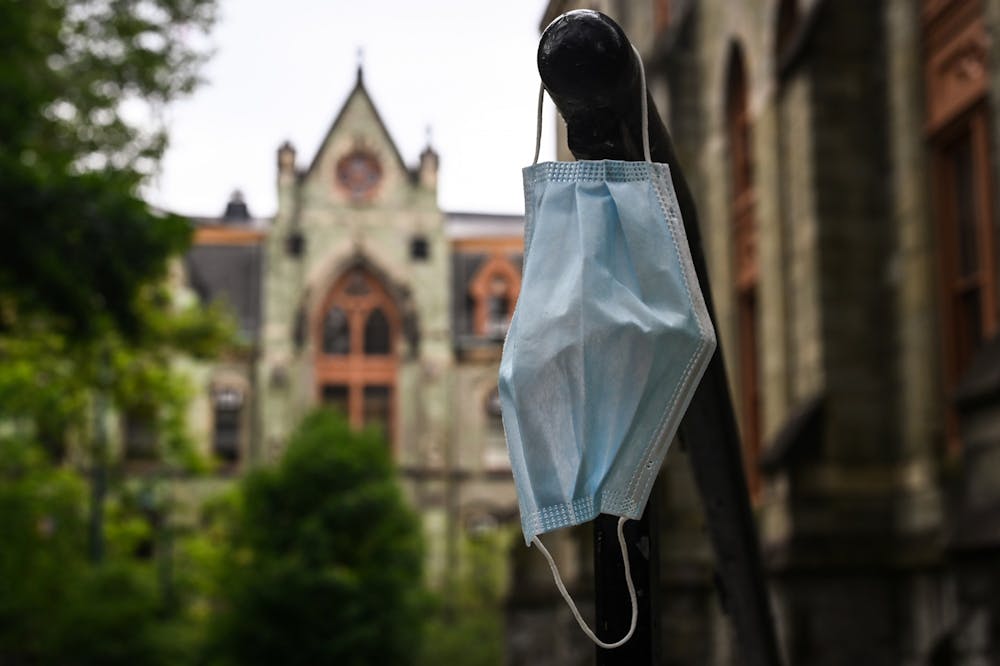After nearly one month of optional indoor masking, Penn has reinstated required masking for all indoor public and shared campus spaces. The mandate will take effect on April 18.
In a Wednesday afternoon email to the Penn community, Interim President Wendell Pritchett, Interim Provost Beth Winkelstein, Senior Executive Vice President Craig Carnaroli, and Executive Vice President for the Health System J. Larry Jameson wrote that the decision to reverse the mask mandate lift was implemented in alignment with revised guidance from the City of Philadelphia.
Exceptions to the masking requirement include single occupancy offices and shared spaces where six-foot distancing can be respected.
"We thank you for your great partnership in our ongoing efforts to sustain our shared health and safety," the administrators wrote.
Chief Wellness Officer Benoit Dubé told The Daily Pennsylvanian that the decision to reinstall the indoor mask mandate is simply a “response to a trend.”
“The City has a much larger lens than we have here on our campus,” Dubé said, adding that indoor masking is a temporary response that is not forever. “We’re good at this. We’ve done it before, and it’ll stop the trend from continuing to increase.”
Dubé said it’s a “small sacrifice” for a slightly shorter period of time and that the University needs to be responsive to the changing data.
On-campus cases reflect rising positivity across Philadelphia County, which is now averaging 142 cases per day as of April 11. At Penn, a total of 385 community members tested positive for COVID-19 during the week from April 3 to April 9 — up 113 from the week before. Undergraduates comprised a majority of the new cases, with 214 positive tests.
RELATED:
Philadelphia reinstates indoor mask mandate amid rising COVID-19 cases
Penn's COVID-19 case count nearly doubles, reaching eight-week high
According to research conducted by Penn Medicine in collaboration with Thomas Jefferson University Hospital and the the Children's Hospital of Philadelphia, the BA.2 Omicron subvariant has become the dominant strain of COVID-19 found across the Delaware River Valley in recent weeks.
“We’ve known all along that BA.2 is far more transmissible, and I think we’re just seeing people engaging in normal social interactions, in close proximity to one another indoors, where food and drink are being shared,” Dubé said. “That’s the trifecta — the perfect conditions for people to be exposed and possibly infected.”
Dubé clarified that current on-campus cases have been mostly ones with mild symptoms.
“While there may be more people becoming infected, people are not more sick or more likely to become hospitalized,” Dubé said. “That’s a good sign.”
The citywide announcement was made during a press conference Monday afternoon by the Philadelphia Department of Public Health. The mandate will start to be enforced by the City on April 18 to give businesses a one-week “educational period” to adjust to the policy change.
Philadelphia Health Commissioner Cheryl Bettigole said that she hopes employers will utilize the one-week buffer time to notify staff and patrons about the reintroduced mask mandate.
“We hope that by having folks mask up whenever they’re in public indoor spaces, we can get ahead of the wave and keep it from reaching a peak like we saw in January with the Omicron variant,” Bettigole said. “If we can do that, we can literally save the lives of vulnerable Philadelphians.”
Philadelphia uses key metrics to determine the extent of COVID-19 precautions and to regulate the move from one response tier to another. Since March 2, Philadelphia had been operating under the “All Clear” precautions tier — the lowest of four — which ended the requirement for individuals to wear a mask indoors. With new data reported by the Philadelphia Department of Public Health on April 11, the city moved immediately into the “Mask Precautions” tier.
“Mask Precautions” is enacted if at least two of the three following conditions are met: citywide new cases per day are above 100 but below 225, hospitalizations are above 50 but below 100, and cases have risen by more than 50% in the previous 10 days.
A 60% increase in case counts over the past 10 days and a positive case average of 142 citywide each day were enough to trigger an immediate reinstatement of the indoor mask mandate. However, citywide hospitalizations are slightly below the threshold number at 44, down slightly from last week.
Bettigole said that at the current level of transmission, there should be no reason to panic or to avoid activities, and that by wearing masks, Philadelphians can go about their daily lives without contributing to the transmission of the virus.
Philadelphia’s response tiers originally included percentage of positive COVID-19 tests as a fourth metric, but have since dropped it as a tool for measuring under which precaution level the city should be operating. Positivity rate has recently become unreliable in determining the spread of COVID-19, according to The Philadelphia Inquirer.
Dubé said that the Philadelphia Department of Public Health’s decision to exclude positivity rate from its key metrics is “recognition of the fact that it is a very imperfect measure that is dependent on the denominator.”
Many Philadelphians taking COVID-19 tests at home will not report a negative test. At the same time, symptomatic individuals often take tests at hospitals and testing clinics, where numbers are automatically included in the city’s tally of cases. These two trends lead to higher positivity rates.
Executive Director for Public Health and Wellbeing Ashlee Halbritter said that improving weather allows for more opportunities for students to take advantage of outdoor activities, where community members do not have to wear masks.
“This can be an opportunity to keep us all healthy as we try to finish out the semester,” Halbritter said, adding that at the end of the fall semester, the rise of the Omicron variant made many students sick — forcing them to potentially miss exams and deadlines.









